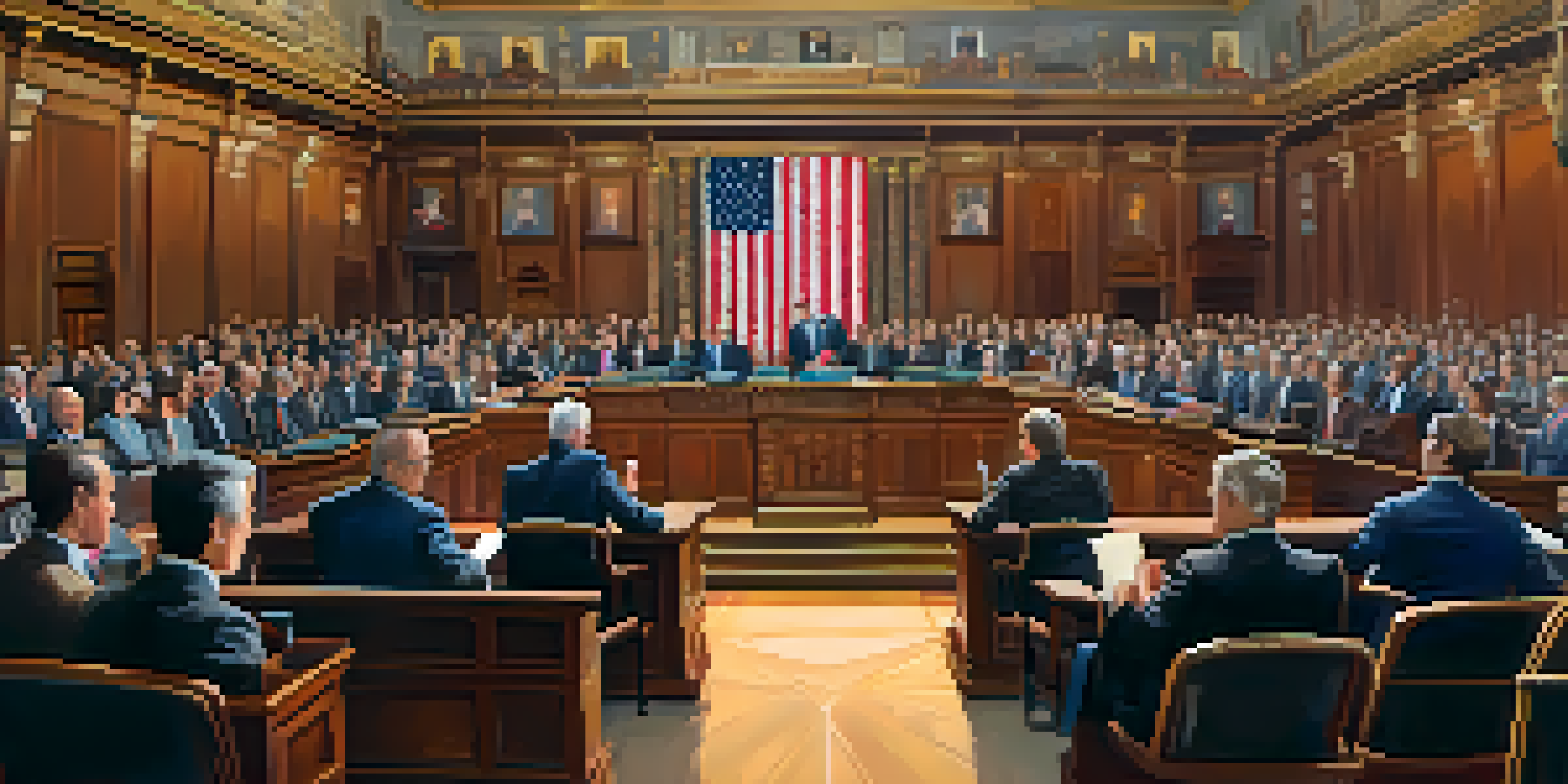Nevada's Legislative Process: How Laws Are Made and Passed

An Overview of Nevada's Legislative Framework
Nevada's legislative process is rooted in its unique political structure, which includes a bicameral legislature. This means there are two separate chambers: the Assembly and the Senate, each with distinct roles. Understanding this framework is crucial as it sets the stage for how laws are proposed, debated, and enacted.
The best way to predict the future is to create it.
The Nevada Legislature meets biennially, meaning it convenes every two years, which adds a layer of urgency to the legislative process. This schedule influences how lawmakers prioritize issues and draft bills, often resulting in intense sessions. The limited timeframe creates a dynamic environment where ideas can quickly evolve into legislation.
Moreover, the state’s constitution outlines the fundamental principles guiding the legislative process. These principles ensure that the process remains transparent and accountable to the citizens of Nevada. This framework not only defines how laws are made but also emphasizes the importance of public participation and feedback.
The Role of Citizens in the Legislative Process
Citizens play a pivotal role in Nevada's legislative process through various avenues such as public hearings, petitions, and direct lobbying. Public hearings allow residents to voice their opinions on proposed legislation, giving lawmakers valuable insights into community needs. This engagement is essential for a representative democracy.

Additionally, citizens can initiate petitions to propose new laws or amend existing ones, empowering them to take an active role in shaping state policy. This grassroots approach fosters a sense of ownership and responsibility among residents, highlighting the importance of community involvement in governance.
Bicameral Legislature in Nevada
Nevada's legislative process operates through a bicameral system with an Assembly and Senate, influencing how laws are proposed and enacted.
Moreover, direct lobbying is another way citizens can influence legislation. By meeting with their elected officials, citizens can discuss issues that matter to them, ensuring their voices are heard. This interaction between lawmakers and constituents is vital for a responsive legislative process.
How a Bill is Introduced in the Legislature
The journey of a bill in Nevada starts with its introduction in either the Assembly or the Senate. A bill can be proposed by a legislator, or sometimes, a citizen through initiatives. This initial step is crucial, as it sets the legislative wheels in motion and opens the floor for discussions.
A government that robs Peter to pay Paul can always depend on the support of Paul.
Once a bill is introduced, it is assigned to a committee that specializes in the bill's subject matter. Committees play a significant role in the legislative process, as they conduct detailed analyses and hold hearings to gather feedback from experts and the public. This stage is essential for refining the bill and addressing any concerns.
After the committee has reviewed the bill, it makes recommendations on whether it should proceed to the full chamber for a vote. This recommendation can either support the bill, suggest amendments, or oppose it. The committee's decision heavily influences the bill's chances of moving forward in the legislative process.
The Committee Review Process Explained
Once a bill is in the hands of a committee, the review process begins, which is often considered the heart of the legislative journey. Committees hold hearings where they gather testimonies from various stakeholders, including experts, advocacy groups, and members of the public. This helps ensure that all perspectives are considered before any decisions are made.
During these hearings, committee members can ask questions and seek clarifications, which can lead to significant changes in the bill. Amendments may be proposed to address concerns raised during the hearings, making the bill more robust and reflective of the community's needs. This iterative process is crucial for good governance.
Citizen Engagement is Key
Citizens actively participate in shaping legislation through public hearings, petitions, and direct lobbying, ensuring their voices are heard.
After thorough review and potential amendments, the committee votes on whether to advance the bill. If it passes, the bill moves to the floor of the chamber for debate among all members. If it does not pass, the bill may be effectively stalled, highlighting the importance of the committee's role in shaping legislation.
Debate and Voting in the Assembly and Senate
Once a bill passes through the committee, it is presented for debate in the full chamber, either the Assembly or Senate. This stage is where lawmakers discuss the bill’s merits, potential impacts, and any remaining concerns. The debate allows for a democratic exchange of ideas and can sometimes get quite spirited.
Following the debate, a vote is taken. Depending on the outcome, the bill may either move forward or be rejected. If the bill receives a majority vote, it advances to the other chamber for similar scrutiny and debate, ensuring that both halves of the legislature have a chance to weigh in.
It’s important to note that each chamber can suggest further amendments, adding layers of complexity to the legislative process. If both chambers agree on the final version of the bill, it is sent to the governor for approval, marking the final stage before it becomes law.
The Governor's Role in the Legislative Process
After a bill successfully passes both the Assembly and Senate, it is sent to the governor, who plays a decisive role in the legislative process. The governor can either sign the bill into law, allowing it to take effect, or veto it, which prevents the bill from becoming law. This decision can have significant impacts on the state's policies and direction.
If the governor chooses to veto the bill, the legislature has the option to override this veto with a two-thirds majority vote in both chambers. This situation highlights the delicate balance of power between the executive and legislative branches, ensuring that no single entity has absolute control over lawmaking.
Governor's Critical Role
The governor's approval or veto of bills plays a decisive role in the legislative process, impacting state policies and governance.
Moreover, the governor may also choose to let the bill become law without signing it, which is known as a 'pocket approval.' This nuanced role underscores the importance of the governor's stance on various issues, as it can shape the legislative landscape and influence future policymaking.
The Importance of Transparency and Accountability
Transparency and accountability are fundamental principles in Nevada's legislative process. These principles ensure that the process remains open to public scrutiny, fostering trust between lawmakers and constituents. By making legislative sessions accessible, citizens can stay informed about decisions that affect their lives.
Moreover, public records and meeting minutes are made available, allowing residents to track how their representatives vote and the rationale behind their decisions. This accessibility empowers citizens to hold their elected officials accountable, ensuring that they truly represent their constituents' interests.

Furthermore, initiatives and referendums allow citizens to directly influence policy, reinforcing the idea that governance is a two-way street. In this way, Nevada's legislative process not only creates laws but also cultivates a culture of participation and civic engagement among its residents.